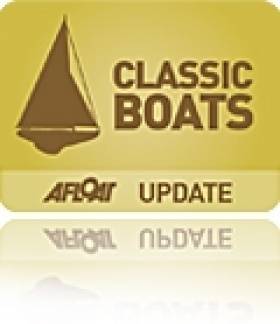Displaying items by tag: Minister of Heritage
#NaomhÉanna - Minister for Heritage, Jimmy Deenihan and Waterways Ireland have agreed to restrain the scrapping of the nation's oldest surviving merchant ship, Naomh Éanna until next week, while a campaign group arrange a survey as previously reported on Afloat.ie, to determine her true condition.
The Save Our Ship (SOS) Naomh Éanna campaign group had sought a target of €15,000 in funds which were raised through social media so to dry dock the iconic vessel and determine the structural integrity of the hull's condition.
The vessel completed in Liffey Dockyard in 1958, is moored in the number 2 graving dock in Grand Canal Dock, Dublin Port and the group are under pressure to have all arrangements made to pump out the dock.
In addition they are to chock the vessel so surveyors can access the critical shallow bottom ballast tanks where her frames and keel could have deteriorated.
Should the frames and keel be wasted to the extent that they need replacing then the vessel would be deemed un-economic to restore unless supported by the state as is common in most developed countries, according to the campaigners.
Waterways Ireland would then instruct their contractors L&M Keatings to destroy the ship.
The Minister and Waterways Ireland have made it very clear they will not assist or absorb any expense relating to this survey. Disregarding her status as the Nation's oldest surviving merchant vessel, her connection to Dublin's ship building heritage and her 30 year service between Galway to the Aran Islands.
She represents historic and cultural ties of island life during a career that many people fondly recall sailing on her, though the Underwater Archeological Unit have declared that she has 'no heritage value whatsoever'.
The SOS group dispute this finding as the European industrial heritage directive dictates any industrial artifact over 25 years old is deserving of protection.
The group also points out the employment potential of such an attraction in Galway Harbour (where a berth is available to her). Her proposed use as a multi-purpose floating venue after restoration would consist of boutique hostel, restaurant, cafe, micro-brewery and museum expects to employ more than 45 people.
Should the group manage to organise the dry docking and ascertain she is salvageable following survey due on 7 May, they are determined to negotiate the transfer of the vessel to a holding company.
This company will work on arranging private finance to restore and refit the ship in Dublin in line with the business plan presented to Minister Deenihan in April. Following repairs they are optimistic she will be able to sail under her own steam to Galway for completion.
Another historic vessel, Mary Stanford that had shared company with Naomh Eanna in Dublin's Grand Canal Dock, returned last weekend to her 'spiritual home' of Ballycotton. Co. Cork, where she is to be restored to glory.
The Barnett-class lifeboat was was renowned for her daring role in the rescue of the Daunt Rock lightship's crew in 1936. For the last two decades there has been a campaign to save her which eventually led to her been hoisted out of the basin in March.
Initially she taken by road to a warehouse in Midleton and last weekend she finally completed her journey to east Cork as the Irish Examiner reported and that of her next stage of restoration.





























































